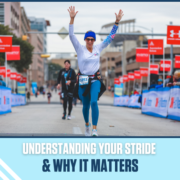Understanding Your Stride: Why It Matters for Runners
Whether you’re an experienced runner or new to the sport, understanding your stride is a crucial element that can impact your performance, comfort, and risk of injury. But what exactly is a stride, and why should you take the time to understand yours?
What is Stride?
In running, a stride refers to the cycle of movements your body goes through with each step you take. It encompasses the way your foot lands, the length of your steps, how your body moves through each step, and your overall running form. Every runner has a unique stride, shaped by their body mechanics, strength, flexibility, and running habits.
Stride can be broken down into several key components:
1. Stride Length: This is the distance covered between two successive foot strikes on the ground. A longer stride isn’t always better—over-striding can lead to inefficiency and injury.
2. Stride Frequency (Cadence): This is the number of steps you take per minute. Elite runners often have a cadence of about 180 steps per minute, but an ideal cadence varies from runner to runner.
3. Foot Strike: This refers to how your foot contacts the ground—whether on the heel, midfoot, or forefoot. Different strike patterns can affect how forces are distributed through your legs.
4. Stride Mechanics: This involves the motion of your legs and arms, your posture, and how your body moves through each step.
Why Understanding Your Stride Matters
1. Improves Efficiency: A well-tuned stride can make your running more efficient, helping you to use less energy for the same pace. Understanding your stride allows you to identify areas where you can make subtle changes to improve your efficiency.
2. Reduces Risk of Injury: Many common running injuries, such as shin splints, runner’s knee, and IT band syndrome, can be linked to stride issues. By analyzing and adjusting your stride, you can help reduce the impact forces and repetitive strain that lead to these injuries.
3. Enhances Performance: Small tweaks to your stride can lead to big gains in speed and endurance. Whether it’s increasing your cadence slightly or adjusting your posture, refining your stride can help you achieve personal bests.
4. Increases Comfort: Running should feel good! A stride that matches your body’s natural mechanics will feel more comfortable, allowing you to enjoy your runs more and stay consistent with your training.
How to Analyze Your Stride
1. Video Analysis: Recording yourself running and reviewing the footage can be a great way to see your stride in action. Many running stores and physical therapy clinics offer gait analysis services that provide insights into your stride mechanics.
2. Wearable Technology: Devices like GPS watches and running apps can provide data on your cadence, stride length, and more. This data can help you identify trends and areas for improvement.
3. Professional Assessment: A physical therapist or running coach can offer a detailed analysis and personalized advice based on your specific needs and goals.
4. Self-Assessment: Pay attention to how you feel when you run. Are you landing heavily? Are your steps too long or too short? Sometimes, simply tuning into your body can offer valuable insights.
Tips for Improving Your Stride
1. Focus on Cadence: Aim for a cadence of around 170-180 steps per minute. This can help reduce the impact on your joints and promote a more efficient stride.
2. Avoid Over-Striding: Keep your steps short and quick, with your foot landing under your body rather than in front of it. This helps to reduce braking forces and keeps you moving forward efficiently.
3. Strength and Flexibility Training: Incorporating exercises that strengthen your core, glutes, and legs, along with stretching, can improve your stride mechanics.
4. Listen to Your Body: Make gradual changes and listen to how your body responds. If something feels off, it might be a sign that your stride needs a tweak.
Understanding your stride is more than just a technical aspect of running—it’s about making running a more enjoyable, sustainable, and rewarding experience. Take the time to explore your stride, and you might just find that those small adjustments can lead to big improvements on race day.
Happy running!



